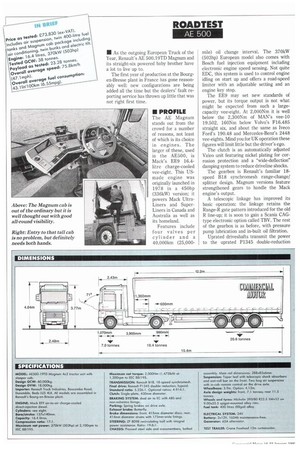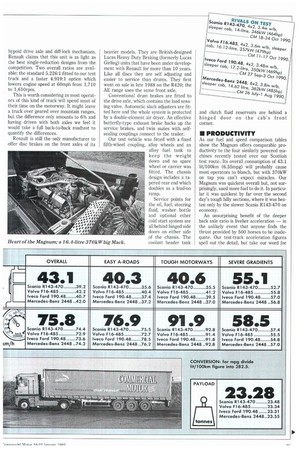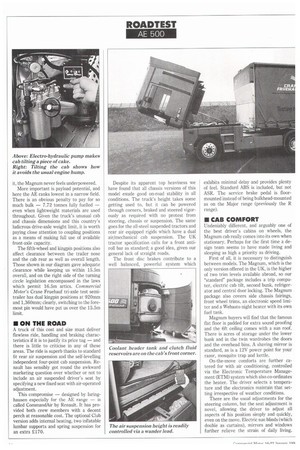iii As the outgoing European Truck of the Year, Renault's
Page 26

Page 27

Page 28

Page 29

If you've noticed an error in this article please click here to report it so we can fix it.
AE 500.19TD Magnum and its straight-six powered baby brother have a lot to live up to.
The first year of production at the Bourgen-Bresse plant in France has gone reasonably well: new configurations are being added all the time but the dealers' fault reporting service has thrown up little that was not right first time.
• PROFILE The AE Magnum stands out from the crowd for a number of reasons, not least of which is its choice in engines. The larger of these, used in the AE500, is Mack's EE9 16.4litre charge-cooled vee-eight. This USmade engine was originally launched in 1978 in a 450hp (336kW) version; it powers Mack UltraLiners and SuperLiners in Canada and Australia as well as its homeland.
Features include four valves per cylinder and a 40,000km (25,000 mile) oil change interval. The 370kW (503hp) European model also comes with Bosch fuel injection equipment including electronic engine speed sensing. Not quite EDC, this system is used to control engine idling on start up and offers a road-speed limiter with an adjustable setting and an engine key stop.
The EE9 may set new standards of power, but its torque output is not what might be expected from such a largecapacity vee-eight. At 2,000Nm it is well below the 2,300Nm of MAN's vee-10 19.502, 160Nm below Volvo's F16.485 straight six, and about the same as Iveco Ford's 190.48 and Mercedes-Benz's 2448 vee-eights. Mind you for UK operation these figures will limit little but the driver's ego.
The clutch is an automatically adjusted Valeo unit featuring nickel plating for corrosion protection and a "wide-deflection" damping system to reduce driveline shocks.
The gearbox is Renault's familiar 18speed B18 synchromesh range-change/ splitter design. Magnum versions feature strengthened gears to handle the Mack engine's output.
A telescopic linkage has improved its basic operation: the linkage retains the Range-R gate pattern introduced for the old R line-up; it is soon to gain a Scania CAGtype electronic option called TBV. The rest of the gearbox is as before, with pressure pump lubrication and in-built oil filtration.
Uprated driveshafts transmit the power to the uprated P1345 double-reduction hypoid drive axle and diff-lock mechanism. Renault claims that this unit is as light as the best single-reduction designs from the competition. Two overall ratios are available: the standard 5.226:1 fitted to our test truck and a faster 4.919:1 option which lowers engine speed at 60mph from 1,710 to 1,610rpm.
This is worth considering as most operators of this kind of truck will spend most of their time on the motorway. It might leave a truck over geared over mountain ranges, but the difference only amounts to 6% and having driven with both axles we feel it would take a full back-to-back roadtest to quantify the differences.
Renault is still the only manufacturer to offer disc brakes on the front axles of its heavier models. They are British-designed Lucas Heavy Duty Braking (formerly Lucas Girling) units that have been under development with Renault for more than 10 years. Like all discs they are self adjusting and easier to service than drums. They first went on sale in late 1988 on the R420; the AE range uses the same front axle.
Conventional drum brakes are fitted to the drive axle, which contains the load sensing valve. Automatic slack adjusters are fitted here and the whole system is protected by a double-element air dryer. An effective butterfly-type exhaust brake backs up the service brakes, and twin suzies with selfsealing couplings connect to the trailer.
Our test vehicle was fitted with a fixed fifth-wheel coupling, alloy wheels and an alloy fuel tank to keep the weight down and no spare wheel or carrier was fitted. The chassis design includes a tapered rear end which doubles as a lead-on ramp.
Service points for the oil, fuel, steering fluid, washer bottle and optional ether cold start system are all behind hinged side doors on either side of the chassis. The coolant header tank and clutch fluid reservoirs are behind a hinged door on the cab's front corner.
• PRODUCTIVITY
As our fuel and speed comparison tables show the Magnum offers comparable productivity to the four similarly powered machines recently tested over our Scottish test route. Its overall consumption of 43.1 lit/100km (6.55mpg) will probably cause most operators to blanch, but with 370kW on tap you can't expect miracles. Our Magnum was quickest overall but, not surprisingly, used more fuel to do it. In particular it was quickest by far over the second day's tough hilly sections, where it was beaten only by the slower Scania R143-470 on economy.
An unsurprising benefit of the deeper back axle ratio is livelier acceleration in the unlikely event that anyone finds the thrust provided by 500 horses to be inadequate. Our test-track acceleration figures spell out the detail, but take our word for it, the Magnum never feels underpowered.
More important is payload potential, and here the AE ranks lowest in a narrow field. There is an obvious penalty to pay for so much bulk — 7.72 tonnes fully fuelled — even when lightweight materials are used throughout. Given the truck's unusual cab and chassis dimensions and this country's ludicrous drive-axle weight limit, it is worth paying close attention to coupling positions as a means of making full use of available front-axle capacity.
The fifth-wheel and kingpin positions also affect clearance between the trailer nose and the cab rear as well as overall length. Those shown in our diagram gave adequate clearance . while keeping us within 15.5m overall, and on the right side of the turning circle legislation encompassed in the laws which permit 16.5m artics. Commercial Motor's Crane Fruehauf tri-axle test semitrailer has dual kingpin positions at 920mm and 1,360mm; clearly, switching to the foremost pin would have put us over the 15.5m limit.
• ON THE ROAD
A truck of this cost and size must deliver flawless ride, handling and braking characteristics if it is to justify its price tag — and there is little to criticise in any of these areas. The ride is superb thanks to standard fit rear air suspension and the self-levelling independent four-point cab suspension. Renault has sensibly got round the awkward marketing question over whether or not to include an air suspended driver's seat by specifying a new fixed seat with air-operated adjustment.
This compromise — designed by Isringhausen especially for the AE range — is called CommandAir by Renault. It has provided both crew members with a decent perch at reasonable cost. The optional Club version adds internal heating, two inflatable lumbar supports and spring suspension for an extra £170. Despite its apparent top heaviness we have found that all chassis versions of this model exude good on-road stability in all conditions. The truck's height takes some getting used to, but it can be powered through corners, braked and steered vigorously as required with no protest from steering, chassis or suspension. The same goes for the all-steel suspended tractors and rear air equipped rigids which have a dual air/mechanical cab suspension. The UK tractor specification calls for a front antiroll bar as standard; a good idea, given our general lack of straight roads.
The front disc brakes contribute to a well balanced, powerful system which exhibits minimal delay and provides plenty of feel. Standard ABS is included, but not ASR. The service brake pedal is floormounted instead of being bulkhead-mounted as on the Major range (previously the R range).
• CAB COMFORT
Undeniably different, and arguably one of the best driver's cabins on wheels, the Magnum cab really comes into its own when stationary. Perhaps for the first time a design team seems to have made living and sleeping as high a priority as driving.
First of all, it is necessary to distinguish between models. The Magnum, which is the only version offered in the UK, is the higher of two trim levels available abroad, so our standard" package includes a trip computer, electric cab tilt, second bunk, refrigerator and central door locking. The Magnum package also covers side chassis fairings, front wheel trims, an electronic speed limiter and a Webasto night heater with its own fuel tank.
Magnum buyers will find that the famous flat floor is padded for extra sound proofing and the 6ft ceiling comes with a sun roof. There is acres of storage under the lower bunk and in the twin wardrobes the doors and the overhead bins. A shaving mirror is standard, as is a 12V power point for your razor, mosquito trap and kettle.
On-the-move comforts are further catered for with air conditioning, controlled via the Electronic Temperature Management (ETM) system which also co-ordinates the heater. The driver selects a temperature and the electronics maintain that setting irrespective of weather conditions.
There are the usual adjustments for the steering column, but the seat adjustment is novel, allowing the driver to adjust all aspects of his position simply and quickly, even on the move. Electric sun blinds (which double as curtains), mirrors and windows further relieve the strain of daily living. Quirks include the provision of a speedometer as well as the tachograph, but all-inall the overwhelming difference between this and any ordinary cab is one of space lots of it.
Visibility is good, thanks to the height and the large expanse of glass and mirrors, but urban driving can be disconcerting as it's hard to know if there's anything under your wheels; the usual blindspots are magnified by the height, which also complicates entry and exit. Once you're used to the Magnum this isn't a problem, but as the Lothian & Borders policeman who stopped us for a chat during our roadtest can vouch, climbing the cab with one hand is not on. You really do need both hands free to grip the rails and climb the ladder straight before sidestepping your way aboard.
Exit is best achieved by walking forwards out of the door, then swinging your body through 180° before climbing down the steps backwards.
• SUMMARY
Renault Truck Industries says that so far 16 Magnums have been registered in this country, of which nine are 283kW (380hp) versions and seven boast the full 500 horses. That 56/44% split is being repeated across the Continent where around 600 AEs are now on the road. The ratio of Mack vee-eight-powered chassis to Renault straight-six chassis is a good deal higher than Renault Vehicules IndustrieIs was predicting over a year ago. It seems that the horsepower race is not over yet.
So, having made the decision to spend £73,830 minus whatever discount you can squeeze out of the dealer, what do you get for your money?
It's obviously a lot of truck, but less certain is the quality of service and fault diagnosis from dealers' staff, given an unfamiliar product and minimal parts stock due to the small numbers on the road.
In any case, do you really need the full 500 horsepower? Do you really want the unfamiliarity of a Mack engine when Renault has consistently designed and built some of Europe's most fuel-efficient and reliable truck engines? Probably not. The fact is the AE 380.19TD is a cheaper, lighter, more fuel efficient truck which is easier to maintain than its big brother.
Prospective buyers might also like to ask themselves if they shouldn't be looking at the new Major R380.19TD. The significant differences between this model and the new AE are a smaller alternator and cab, a larger choice in gearbox and axle ratios and a considerable saving in cash and weight.
Then again, if you like a French engine, but want more than 380hp, you could always wait for the 420hp version of the 12litre unit which should become available later this year, if you can bear to wait. But one thing's for sure. Whichever version of the AE you go for, you're sure to please one person-your driver.
0 by Danny Coughlan




















































































